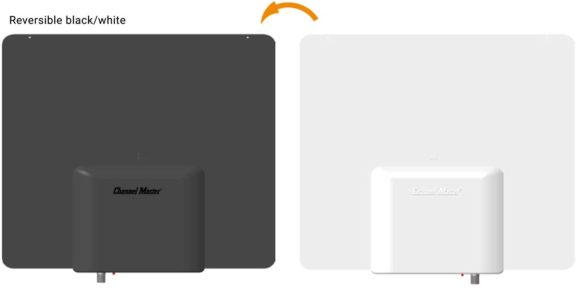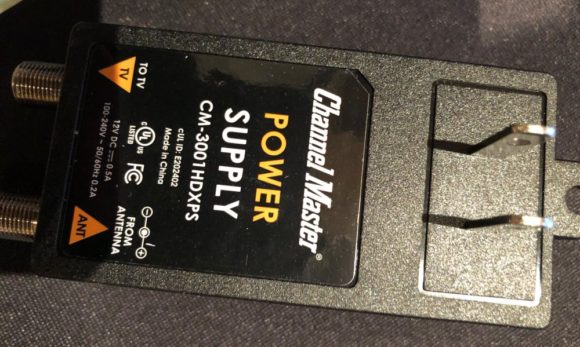
Channel Master just unveiled an $89 “smart” antenna, featuring “seven different reception patterns.” And I had the same question as you – what does that even mean? So I rang up VP Joe Bingochea to get some answers.
It turns out the company has partnered with Ethertronics to integrate a variant of their “active steering” technology, also implemented within Samsung handsets for years and years. The amplified SMARTenna+ incorporates a tuner and some digital circuitry that will automatically scan the airwaves at first power up and then polarize the antenna elements for max receptivity – in this case, they’re going with the highest channel count as the preferred “pattern” (and presumably, in case of tie, higher quality signals would prevail). However, Channel Master recognizes your favorite channel may be an outlier, so the button on the bottom of the antenna manually steps through those patterns, should one need to fine-tune… in the literal sense. As an analogy, Joe reminded me of those old, powered rabbit ears that sported a dial.
Of course, the pinnacle of this technology would be a bundled antenna and set-top to match optimal “pattern” with currently tuned channel on the fly – something it turns out Sezmi had actually implemented back in the day and something Channel Master may look to in the future.
After watching the video, another question I had: Given that single coaxial connection, how does it receive power? It turns out Channel Master filed a few coax-related patents, including a push button connection. But beyond that, both data and power flow over “mini” coax and are split at the power adapter (as shown below).

Channel Master is currently accepting pre-orders and intends to begin shipping the SMARTenna+ in March.
If this works as planned, it will be a must have for any home which can’t, or won’t, install an outdoor antenna. I was surprised how well the $10 Channel Master first gen Flatenna worked for me, and a lot of my friends.
The power over Coax is implemented better than previous iterations. I put in an order but will be a few months before they release/ship. Looks good.
The technology is sound, but might not benefit everyday use with a multi tuner DVR.
I’ve got a TiVo Romio and try to receive stations at different distances and compass angles.in Seattle. You wouldn’t think that the difference between 141 and 127 would make much difference but with hills and weather, sometimes all that I want gets recorded and sometimes it’s dropped out completely.
http://www.antennaweb.org/ is great for telling me directions..
KOMO-DT 4.1 ABC – RF Channel: 38 – 4 miles at 140°
KING-DT 5.1 NBC – RF Channel: 48 – 4 miles at 138°
KIRO-DT 7.1 CBS – RF Channel: 39 – 4 miles at 141°
KCTS-DT 9.1 PBS – RF Channel: 9 – 6 miles at 127°
KSTW-DT 11.1 CW – RF Channel: 11 – 6 miles at 127°
KCPQ-LD 13.1 FOX – RF Channel: 22 – 6 miles at 127°
KCPQ-DT 13.1 FOX – RF Channel: 13 – 22 miles at 227°
I AM VERY MUCH INTERESTED IN REVIEWS FOR ZIP 30286.
Reception inversely proportional to percentage of capital letters, I’m thinking. ;) While zip is a good start, location within that zip, location within the house, home materials, etc all impact antenna performance.
Will this work for zip…18255
Will this work in extremely rural areas? Closest local station is 25 mi. Houston is 100 mi. San Antonio is 150. Austin n Corpus Christi 140.
Be curious how well this works, usually designs of the square type have not done well with VHF compared to rabbit ears. Wall mounts don’t play well with walls with metal mesh. But we’ll see.